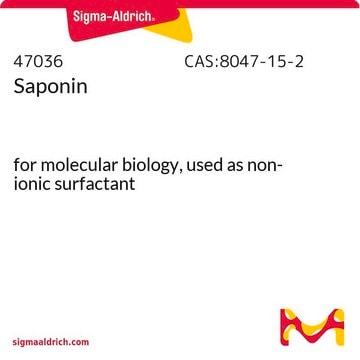300410
Digitonin, High Purity
CAS 11024-24-1 is a non-ionic detergent commonly used to solubilize membrane-bound proteins.
Synonym(s):
Digitonin, High Purity, Digitin
About This Item
Recommended Products
Quality Level
form
powder
manufacturer/tradename
Calbiochem®
storage condition
OK to freeze
desiccated
aggregation number
60 - 70
color
white
shipped in
ambient
storage temp.
15-25°C
InChI
1S/C56H92O29/c1-19-7-10-56(75-17-19)20(2)31-45(85-56)37(67)32-22-6-5-21-11-26(24(61)12-55(21,4)23(22)8-9-54(31,32)3)76-50-42(72)39(69)44(30(16-60)80-50)81-53-48(47(36(66)29(15-59)79-53)83-49-40(70)33(63)25(62)18-74-49)84-52-43(73)46(35(65)28(14-58)78-52)82-51-41(71)38(68)34(64)27(13-57)77-51/h19-53,57-73H,5-18H2,1-4H3/t19?,20-,21-,22+,23-,24+,25+,26+,27+,28+,29+,30+,31-,32+,33-,34+,35-,36+,37-,38-,39+,40+,41+,42+,43+,44-,45+,46-,47-,48+,49-,50+,51-,52-,53-,54+,55-,56+/m0/s1
InChI key
UVYVLBIGDKGWPX-QYLWGQLPSA-N
General description
Warning
Reconstitution
Other Notes
Legal Information
Signal Word
Danger
Hazard Statements
Precautionary Statements
Hazard Classifications
Acute Tox. 3 Oral - STOT RE 2
Storage Class Code
6.1C - Combustible acute toxic Cat.3 / toxic compounds or compounds which causing chronic effects
WGK
WGK 3
Flash Point(F)
Not applicable
Flash Point(C)
Not applicable
Certificates of Analysis (COA)
Search for Certificates of Analysis (COA) by entering the products Lot/Batch Number. Lot and Batch Numbers can be found on a product’s label following the words ‘Lot’ or ‘Batch’.
Already Own This Product?
Find documentation for the products that you have recently purchased in the Document Library.
Customers Also Viewed
Our team of scientists has experience in all areas of research including Life Science, Material Science, Chemical Synthesis, Chromatography, Analytical and many others.
Contact Technical Service












